Why does the bark of an apple tree peel off and what to do?
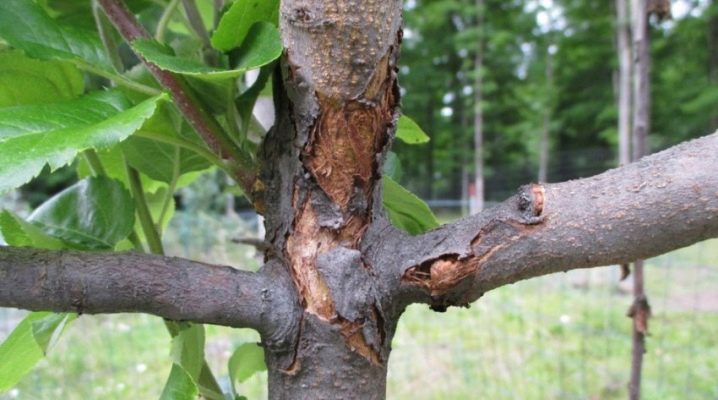
Any damage to the trunk of a fruit tree can cause serious damage to the apple tree and even cause it to wilt. That is why it is very important to take measures to save the garden culture. In this article, we will look at what to do if the bark cracks.
Causes
In order to choose the appropriate method for treating an apple tree, you should establish the reason why the bark is peeling off. To do this, you need to take a closer look at the nature of the damage - they can indicate a sign of pathology.
For example, due to improper pruning and errors in wound treatment, fungi, viruses and pathogenic bacteria enter the bark. In addition, the bark begins to burst and fall off if the rules of agricultural technology are not followed.


Diseases
A common cause of apple tree bark cracking is black cancer. This disease often occurs when the rules for caring for a garden crop are not followed. The infection poses a serious threat to the plant and can cause the tree to die.
The first sign of black cancer is depressed spots of a brownish-purple color. As the disease progresses, they grow in concentric zones, then the bark begins to darken, taking on a burnt appearance. If not taken care of, the tree will become covered with a fine net and the bark will begin to fall off, exposing the darkened wood.
The affected areas look bumpy. Soon, the infection spreads to the leaves and fruits.
In the case of a ring lesion of the branch, it can dry out for several months. And after 3-4 years the whole plant withers.
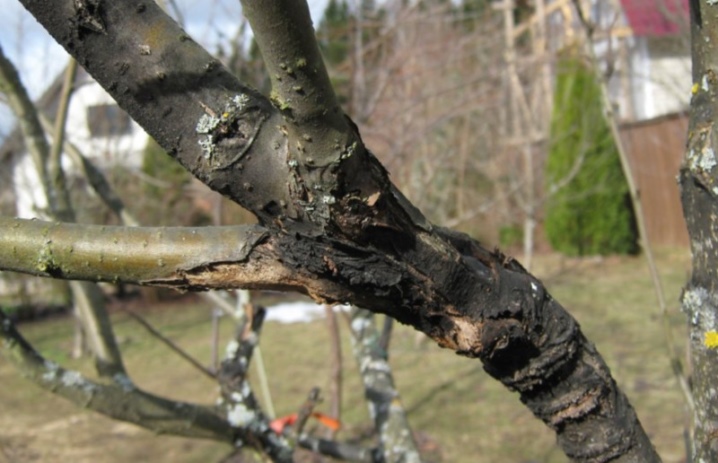
Another cause of bark damage is European cancer. In this case, deep bursts and cracks appear at the site of the lesion, reaching the core of the tree. It is almost impossible to save an apple tree in such a situation.
Common apple infections include bacterial burns. This disease affects not only apple trees, but also quince, pear and hawthorn. Bacteria are carried by insects, birds and even the wind. If, by the time of defeat, the fruits have managed to set on the apple tree, they stop in development, dry up, darken, but do not fall from the branches. The bark becomes soft, loose and covered with whitish drops, as the disease progresses, they acquire a yellowish tint. If untreated, the bark begins to crack, exposing the wood.
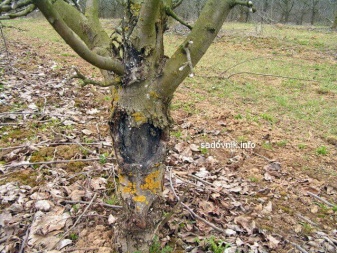
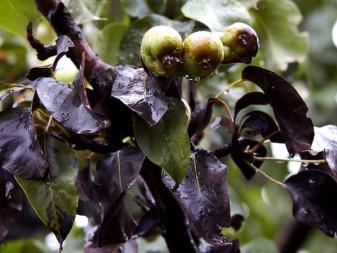
Pests
Fruit trees can be damaged by rodents - mice, rats and hares. These animals will never refuse to feast on the bark of the apple tree, since it does not have a bitter taste, unlike the bark of other fruit plants. Usually, rodents attack young plants because of their softness, their attack can spoil the plant in the shortest possible time, up to the cambium. In this case, only grafts can save the tree.
Bark beetles can cause damage to the bark. This small insect is about 4 mm long and has a dark brown body. Colonies of beetles live in wood, so it is very difficult to notice them.
At the end of the flowering of the tree, insects begin to fly out of their hiding places, mate and infect other garden crops. Females lay eggs under the bark of young seedlings, for this they make multiple moves. Larvae live in them until spring, but as soon as warmth comes, they pupate and transform into sexually mature individuals.
You can identify pests by small holes from which wood dust is poured.
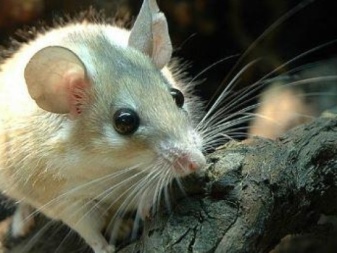
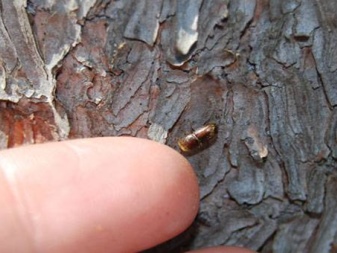
Wrong agricultural technique
According to the laws of nature, the bark and wood of a tree should grow in the same way. However, sometimes the growth of wood for some reason is accelerated, and the bark cannot adapt to it. A mismatch in the growth rate leads to the appearance of crevices in the stem. Through them, fungi, bacteria and insect pests get inside, they worsen the condition of the tree.
Such a rapid growth usually occurs when there is an excess of nitrogen-containing fertilizers or when preparing dressings with an excess of the permissible concentration of the solution. Cracking of the bark is also observed when applying dressings at the stage of pouring the fruits. If you feed the seedlings during this period, the wood will begin to grow 2-3 times faster, and this will inevitably cause cracks in the bark.
Another undesirable factor is excessive moisture. If the trees are regularly flooded with water, this will provoke an increase in the pressure of the liquid inside the trunk. Sooner or later, the bark will break down and begin to burst.
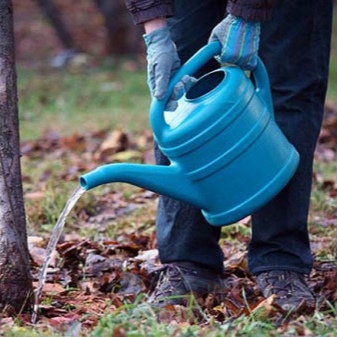
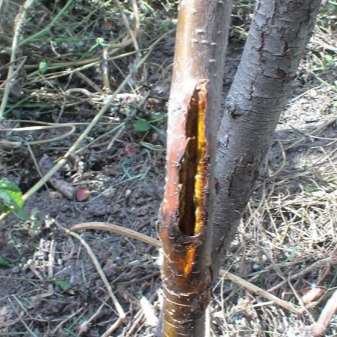
If thermophilic varieties are grown in areas with harsh winters, the tree may also suffer. During severe frosts, the juices inside the plant freeze, but when the thaw begins, the pressure inside rises - as a result, the bark moves away from the trunk.
Sunburns are no less dangerous, they affect mainly young trees and look like brown or reddish spots. They usually appear in early spring, when a seedling that has not had time to move away from winter frosts is exposed to the scorching rays of the March sun. UV rays cause overdrying and cracking of the bark.
Mass burns can damage large fragments of the trunk and lead to wilting of the tree.
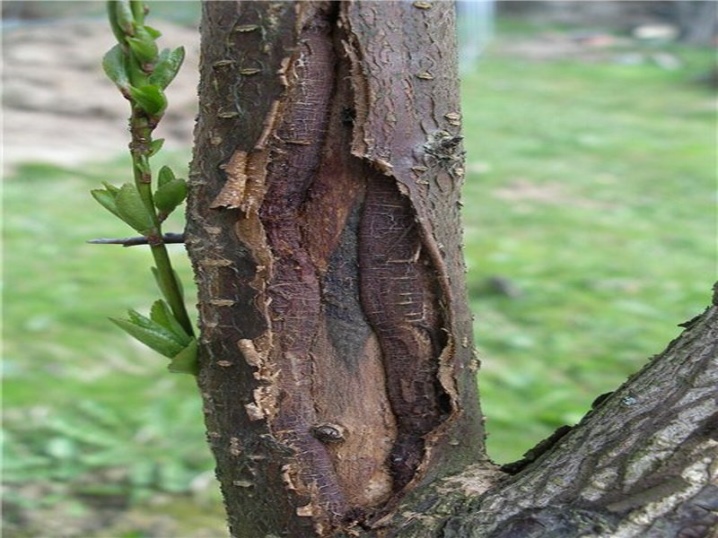
How to treat?
If an apple tree is affected by black cancer, then it can be saved only in the initial stages of the disease. To do this, it is necessary to cut off all damaged branches and clean out the infected bark, capturing 2-3 cm of healthy tissue. The damaged parts of the plant should be burned, and the wounds should be treated with a solution of iron or copper sulfate. If the infection has reached a large size, the fruits have rotted and the leaves have dried up, such a tree must be cut down and burned.
If the damage is related to frost burrs, action should be taken to prevent flaking. In this case, a homemade chatterbox made from lime, manure and clay, taken in a 1: 1: 3 ratio, will help. If the area of the bark is already damaged by frost, a clay solution should be applied to the wounds. It is prepared at the rate of 200 g of fatty clay and 50 g of lime, the mixture is diluted with water to the consistency of thick sour cream.
In addition to burns, in early spring, transverse wounds may appear on the trunk on the southern and southwestern sides under the old branches. In this case, the dead layer should be thoroughly cleaned and treated with a mixture of lard and wax, taken in equal proportions.
In case of significant delamination of the bark, the surface is cleaned to intact areas and treated with the same solution.

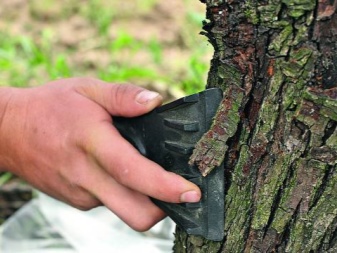
How to restore the bark?
Any wounds in young plants resulting from damage to the bark require prompt treatment in order to restore the coating. In this case, it is necessary to remove all dead bark and cover the wound with a thin layer of garden varnish. If the wound is large, first it must be treated with potassium permanganate, dried and applied with a rag soaked in "Zircon" or "Citovit". And after 24 hours, apply a compound for sealing furnace seams to the damaged area.
If most of the bark has fallen off, the areas of delamination should be cleaned and the exposed areas should be covered with a bandage.
It is advisable to paint the bandage with white paint to prevent excessive heat. With the arrival of warm days, the bandage is removed, and the wound is re-treated with clay.
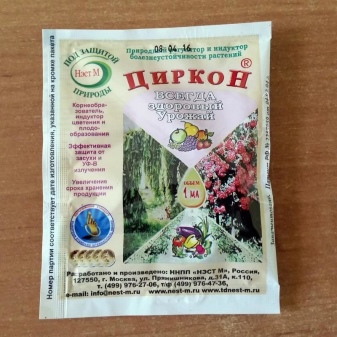
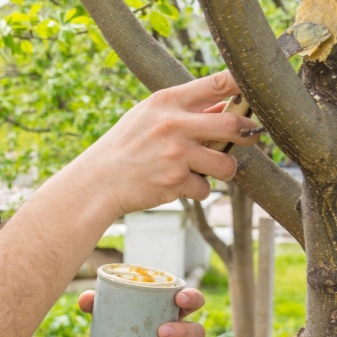
Prevention measures
Any disease is easier to prevent than to cure. This also applies to damage to the bark of apple trees. To prevent infection, preventive measures should be taken.
- If the bark on the apple tree begins to crack due to the scorching sunlight, it is necessary to cover the trunk with a white linen during hot daytime hours.
- In order to prevent damage by rodents, young trunks are wrapped in durable material for the winter, which neither rats nor mice can bite through.
- At the first signs of pathology, all damaged areas must be removed and burned. Otherwise, pests and infections will quickly move to neighboring plantings.
- Wounds should be lubricated with antiseptic solutions or garden varnish.
- The stem and skeletal branches of the apple tree should be whitewashed every spring and autumn. It will create effective protection against frost, protect you from the scorching March rays and protect you from pests. When processing mature trees, you can add a little lime - it will prevent the development of fungal diseases.
- To protect old trees over 8 years old, seasoned gardeners advise from time to time to peel off the bark, which naturally flakes and flakes. However, this is permissible only in regions with mild winters, since peeled trees tolerate frosts worse and can die at strong subzero temperatures.

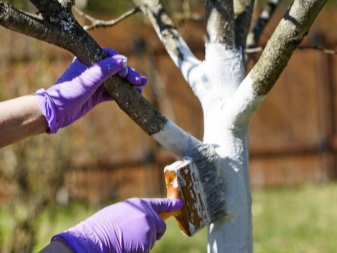
Thus, the removal of the affected parts of the plant and the timely processing of fruit crops can prevent cracking of the apple tree bark. For planting this culture, you should select sunny areas without drafts and a high location of groundwater, away from street toilets and compost pits.
These simple measures will greatly reduce the risk of damage to the bark of apple trees.
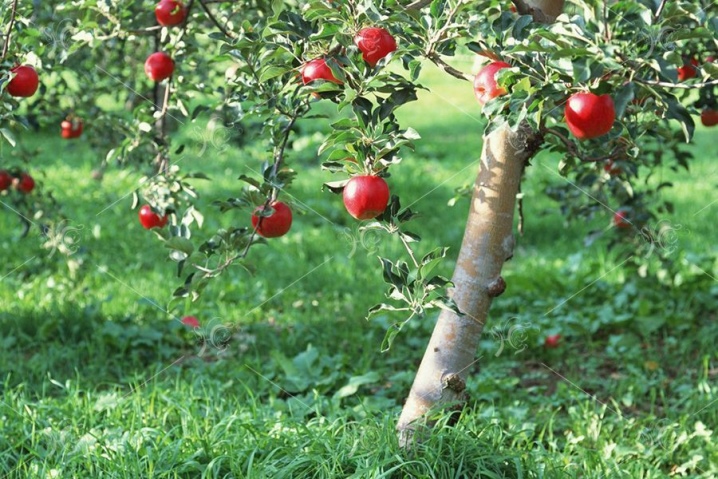













The comment was sent successfully.